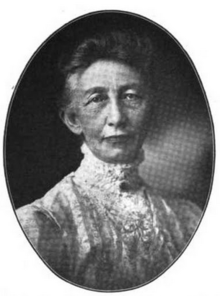Elizabeth Follansbee
Elizabeth Ann Follansbee (December 9, 1839 – August 22, 1917) was an American medical doctor, the first woman on the faculty of a medical school in California.

Early life
Elizabeth Ann Follansbee was born in Pittston, Maine,[1] or possibly Dorchester, Massachusetts, the daughter of a sea captain.[2] She was the great-granddaughter of Roger Sherman, a signer of the Declaration of Independence.[3] She attended medical school at the University of California, one of only two women students enrolled there in 1875. Facing much resistance, she left after a year and continued her medical training at the University of Michigan, before completing her degree in 1877 at the Woman's Medical College of Pennsylvania.[1]
Career
_(14782149305).jpg)
Follansbee returned to California. Along with Charlotte Blake Brown and a few other women doctors, she co-founded the Women and Children's Hospital of San Francisco.[2] For health reasons she moved to Los Angeles in 1883,[1] where she was the first woman admitted as a member of the Los Angeles County Medical Association. She taught pediatrics and chaired the pediatrics department at the University of Southern California,[4] "the first woman medical school faculty member in California".[5] She arranged for women medical school graduates of the school to intern at the Children's Hospital of San Francisco.[6]
She was an assistant editor of The California Medical and Surgical Reporter when it launched in 1905.[7] For two years, she shared a small practice in pediatrics with Rose Talbot Bullard, another early woman physician in Los Angeles.[8] She was also on-call physician at the Florence Home for Erring Girls in the 1890s.[9] When Charlotte Blake Brown died in 1904, Follansbee wrote her colleague's obituary for a professional journal.[10]
Personal life
Follansbee died in 1917, aged 77 years, in Los Angeles.[11] In 1919, the Cabrillo Chapter of the Daughters of the American Revolution raised money to dedicate a children's hospital bed in memory of Follansbee.[12]
References
- George H. Kress, A History of the Medical Profession of Southern California (1910): 134-135.
- Adelaide Brown, "The History of the Development of Women in California" California and Western Medicine (May 1925): 579-580.
- "Patriotic Ancestry" Southern California Practitioner (1905): 327-328.
- "Faculty, Medical College, University of Southern California 1886" Southern California Practitioner (October 1905): frontispiece.
- Janice Mall, "Becoming a Doctor in the 19th Century" Los Angeles Times (July 21, 1985).
- A. Lois Scully, "Medical Women of the West" Archived 2017-10-27 at the Wayback Machine Western Journal of Medicine (December 1988): 761-763.
- "Editorial Notes" Southern California Practitioner (1905): 40.
- Cecilia Rasmussen, "2 Doctors Who Overcame Sexism" Los Angeles Times (February 27, 2000).
- "It Shelters the Shelterless" Los Angeles Herald (August 31, 1893): 7. via Newspapers.com

- Elizabeth A. Follansbee, "Death of Noted Medical Woman" Southern California Practitioner (May 1904): 180-181.
- "Dr. Elizabeth Follansbee Dead" Southern California Practitioner (September 1917): 147.
- Alice M. Church, "Cabrillo Chapter" Daughters of the American Revolution Magazine (November 1919): 689.
External links
- Elizabeth A. Follansbee's gravesite in Los Angeles, at Find A Grave.